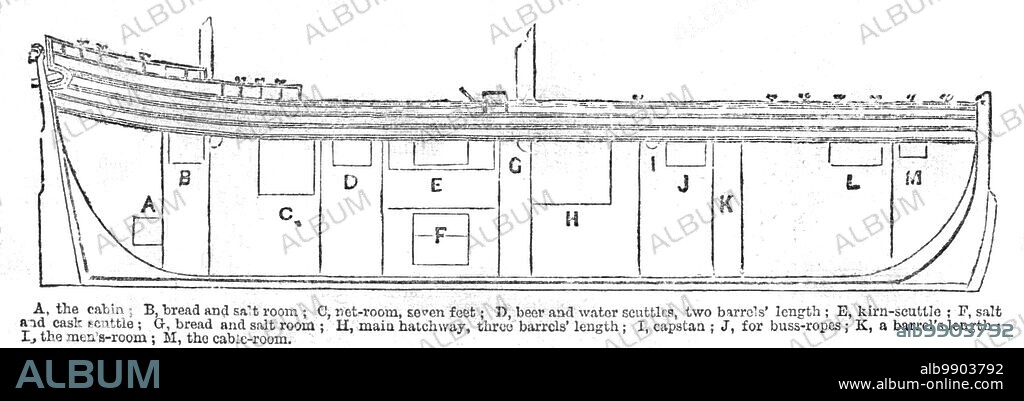alb9903792
Plan of the Herring-buss, 1861. Creator: Unknown.

|
Add to another lightbox |
|
Add to another lightbox |



Title:
Plan of the Herring-buss, 1861. Creator: Unknown.
Caption:
Plan of the Herring-buss, 1861. Section diagram of a fishing boat. 'A. the cabin; B. bread and salt room; C. net-room, seven feet; D. beer and water scuttles, two barrels' length; E. kirn-scuttle; F. salt and cask scuttle; G. bread and salt room; H. main hatchway, three barrels' length; I. captstan; J. for buss-ropes; K. a barrel's length; L. the men's room; M. the cable-room. In regard to the deep-sea fishery, we give our readers some idea of the plan of operations carried on at this period. This fishery being pursued at a distance from home, the vessels employed are necessarily large and of great tonnage, and, as they are absent for a longer period than usual - the time of absence extending from three to six days - many of the operations, ordinarily reserved till the fish are landed, are of necessity pursued on shipboard, involving greater requirements in the description of vessels employed, which, on the average, are from 50 to 80 tons burden, cutter-built; they are technically termed busses, and carry a complement of fifteen men, according to the size of the boat'. From "Illustrated London News", 1861.
Credit:
Album / The Print Collector/Heritage Images
Releases:
Model: No - Property: No
Rights questions?
Rights questions?
Image size:
1981 x 673 px | 3.8 MB
Print size:
16.8 x 5.7 cm | 6.6 x 2.2 in (300 dpi)
Keywords:
19TH CENTURY • ART • ARTS • BLACK & WHITE • BLACK AND WHITE • BOAT • BOATS • BRITAIN • BRITISH • CENTURY • COLOR • COLOUR • DIAGRAM • ENGRAVED • ENGRAVING • FISHING BOAT • FISHING BOATS • FISHING • ILLUSTRATED LONDON NEWS • ILN • NEWSPAPER • NEWSPAPERS • NINETEENTH CENTURY • PRESS • PRINT COLLECTOR, THE • PRINT • STORAGE • TRANSPORT • TRANSPORTATION • WATER TRANSPORT • WHITE AND BLACK
 Pinterest
Pinterest Twitter
Twitter Facebook
Facebook Copy link
Copy link Email
Email

